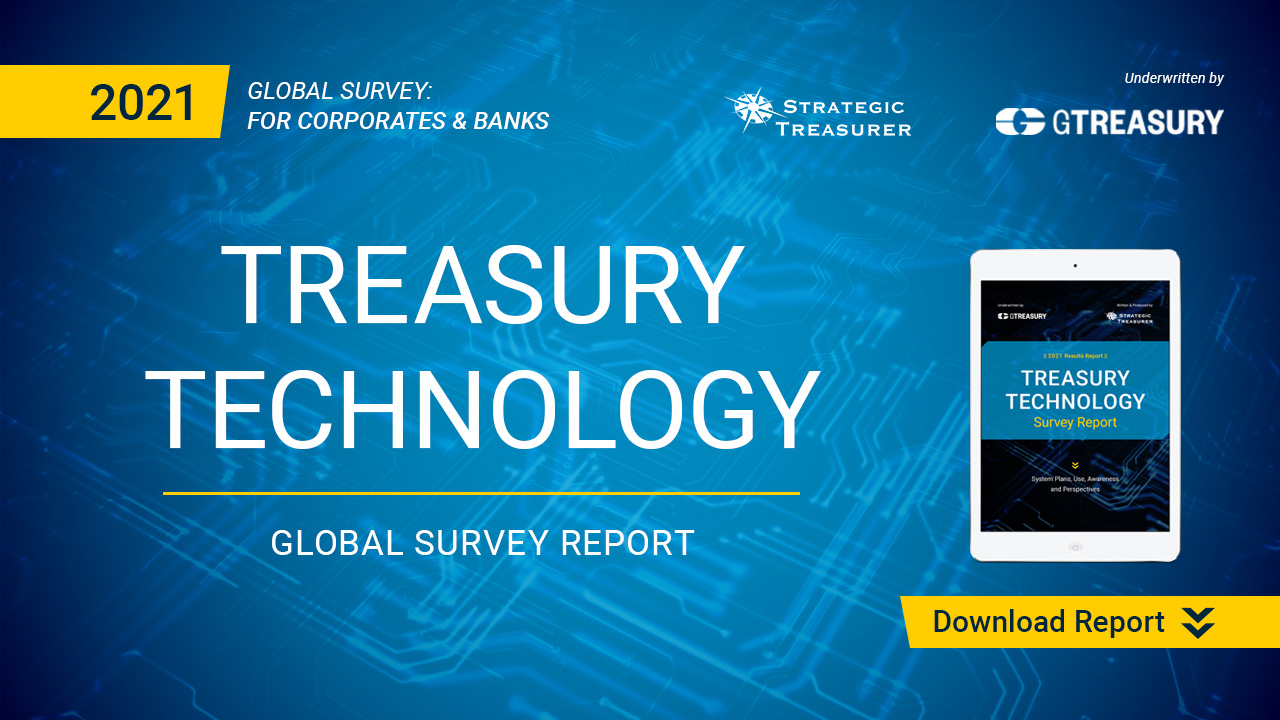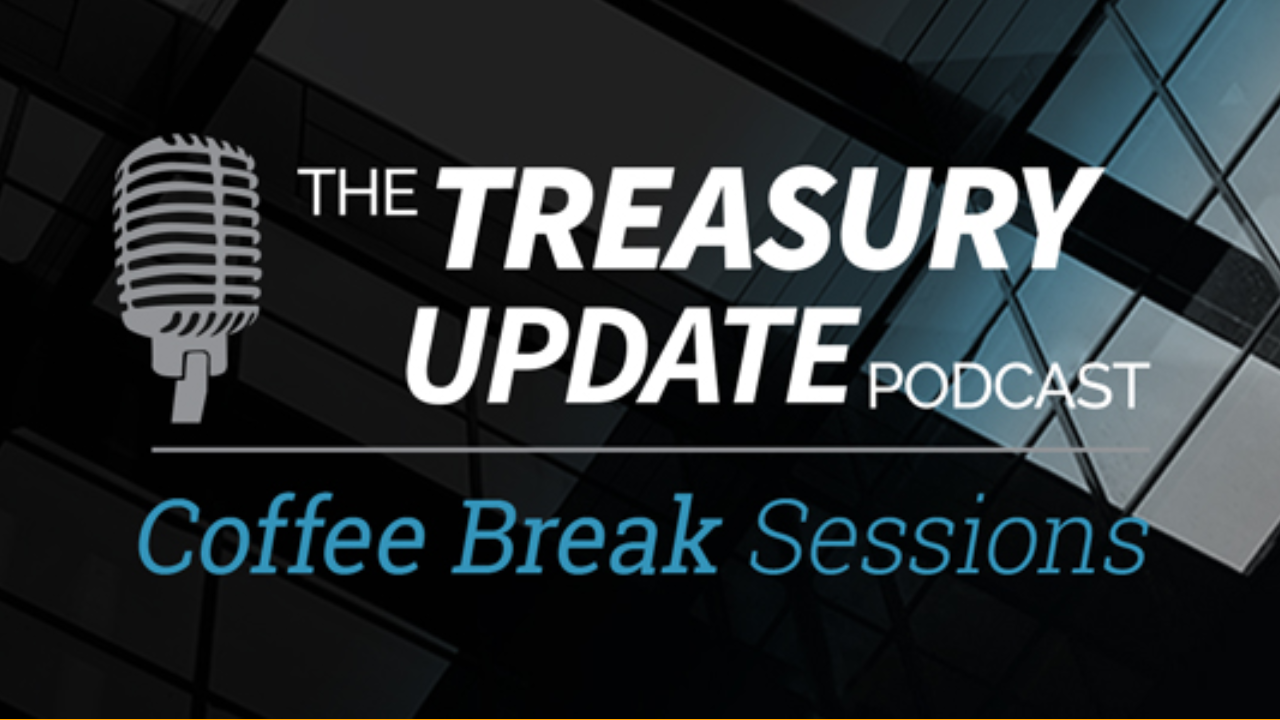
Session 43
Coffee Break Session:
What Is ISO 20022?
Host:
Alexa Cook, Strategic Treasurer


Speaker:
Craig Jeffery, Strategic Treasurer


Episode Transcription - (Coffee Break Session Series) - Episode 44 - What is Iso 20022
Alexa Cook 0:02
Welcome to The Treasury Update Podcast Coffee Break session, the show where we cover foundational treasury topics and questions in about the same amount of time it takes you to drink your coffee.
It is your host Alexa, and I am joined today with Craig Jeffery managing partner of Strategic Treasurer. Welcome back, Craig.
Craig Jeffery 0:18
It’s good to be here Alexa.
Alexa Cook 0:20
Today we are going to cover ISO I-S-O I’m going to say it a couple different ways 222 2022 And I’m just going to ask you right off the bat, how do you say it, Craig?
Craig Jeffery 0:31
20 O 22, so two zero and then other zeros pronounced as, O, and then 22 and that’s because it’s a five-digit number. And that’s the cool way to say it.
Alexa Cook 0:44
So everybody’s doing that. Okay, so what, what is it?
Craig Jeffery 0:48
20022 is a, is part of an international standard international standards organization that handles financial service messages so it’s a common platform to develop these messages.
Alexa Cook 1:04
So how is this standard different from other standards that have, I guess rolled out?
Craig Jeffery 1:08
There’s a number of messaging standards that we’ve seen in play over time. For those in finance, we think of financial messages, there’s an entire universe of messages that we may not be familiar with, but in terms of business documents, it’s a, it’s a pretty modern message format has a multi-part aspect that provides definition of the message structure and that details that come along with it. So, it’s the more modern view. Many people make it equivalent in their minds to the XML format that exists, so the Extensible Markup Language format, like payments like the PAIN.001, for example. They related to the information reporting formats like the CAMT and the .052 or .053 etc. formats. So, in terms of how it’s different think it’s interesting to think about the history. So, if you’re a more European based you think of the message type formats that are in SWIFT like the MT 944 prior day information reporting or you think about wire transfers. Maybe you think of Mt 101 M 2103 depending on whether you’re here at a corporate or a bank side but those are those are formats that came off of a different standard. That standard was still ISO but it was an ISO 15022 We don’t really talk about that we think of those as I think about those as message types, I don’t hear many people other than SWIFT format experts talking about ISO 15022 But once 20022 came along it was much more the focus of discussion, and how that’s rolled out.
Alexa Cook 3:05
What do you mean when you say that it’s not exclusively XML?
Craig Jeffery 3:09
Yeah, this is this is one of those things that people who are messaging pros would love to have those tricky questions, you know, is ISO 20022 xml or not. And the answer is, well, it usually is handled in the form of XML but the structure the details don’t require you to use XML it’s about structure and the details you know a comp there’s a common data dictionary, what you put in there and there’s a common structure, but you don’t have to use XML to make it work. And basically, those are a couple examples of formats that use the ISO 20022 and those that use another format like ISO 15022, or a Bank Administration Institute format. So if you think of prior day information reporting in the US and North America, you might think of BAI2 to Bank Administration Institute, a format for reporting balances and transactions. That would be the example of BAI format from a national standard and then the MT your message type layout would follow the 15022 standard, till the MT 940 and the MT 942 would be examples of prior day 940, and current day recording to be an MT 942. And so that would follow those standards. These are delimited file types that exist. Whereas when you move to prior day and current day in the XML world, still the world of ISO 2022, but using the XML format. They have the CAMT .053 which is prior day current day as CAMT .052. So, they have a whole format for those that exists. If you look at payments, you might think of. there’s a Fedwire format. If you’re in the US if you’re sending things through the bank the MT 101 would be the message type for sending a wire payment in that person in the current version the ISO 2022 format, you’d use a PAIN format will take through SWIFT, or even directly to your financial institution, a PAIN.001 format, for example.
Alexa Cook 5:34
So, that kind of pivots into the next question which is, what’s the difference between SWIFT and 20022?
Craig Jeffery 5:41
Yeah, I know you’re trying to trick me on that one so, SWIFT is a body that works on common standards, they’re also a messaging platform. The difference between SWIFT and ISO 20022 is ISO 20022 is a standard that SWIFT adopts and SWIFT, you know, has moved much of their messaging to the ISO 20022 standards. They certainly served as a body that promoted, you know, moving to this new standard, not only on an international basis between countries, between banks but also in country in many, many ways. So, with their market infrastructure programs, they really push that. So, they’re supportive ISO 20022 is very much related to who they are as a standard setting body and so that it’s easy to think of them as almost synonyms when rather it’s, they’re just very close in terms of an adopted message format.
Alexa Cook 6:43
As a final question, why is ISO 20022 important, and I feel like you’ve already kind of covered on it but maybe this could just be, you know like a light recap of it.
Craig Jeffery 6:53
Why is it important I think because it’s a much richer format, and in today’s world where we can send more information that makes a message better additional information. So, I’ll just give you one quick example and I’m sure some of our listeners have heard me say this before if you have a, let’s say you have a BAI2 message format and has a BAI code. That code can be really useful for things like reconciliation, mapping for cash positioning, it tells you exactly the type of transaction with a three-digit code. XML has a much better format, it’s not that position seven tells you that it’s not the transaction type eight tells you the value of the transaction. Everything comes along with the tags that tell you what it is. So, if there’s $1 amount coming or value coming in says this is the value, it has a tag that tells you what the number means the field means that stronger. But the other part where there’s values. Now you can enrich the CAMT.053 that can be enriched with a BAI code so you can take advantage of, maybe other information that’s been leveraged over time with a much superior format.
Alexa Cook 8:08
Thanks Craig, so just to do a little bit of a recap I know you just kind of did it when is the last question, but really to answer what is ISO 20022 is the standard put out by the International Standards Organization and really it’s just that much richer format to send more information, and it differs from SWIFT and that it’s, it’s a standard in which SWIFT has adopted and it’s really just a multipart format with structures and details that come with it. It’s just the, the modern messaging format. Anything else that you wanted to add to that? I feel like that’s the lite version of it, I guess.
Craig Jeffery 8:46
I think that’s a really good definition. It makes me want to talk about API as well for the idea of communicating information. But that’s a really good overview, thank you.
Alexa Cook 9:00
Yeah, thanks for joining me today, Craig. To all of our listeners, make sure you tune back in with us every first and third Thursday of the month for a new episode. And as always, we look forward to hearing from you, so send us an email with any questions, comments, or topic suggestions at podcast as strategic treasurer.com. Thanks again for joining me, Craig.
Craig Jeffery 9:20
Thank you, Alexa.
OUTRO 9:26
This podcast is provided for informational purposes only, and statements made by Strategic Treasurer LLC on this podcast, are not intended as legal business consulting or tax advice. For more information, visit and bookmark Strategictreasurer.com.
Strategic Treasurer and GTreasury are proud to present the findings from the Treasury Technology Survey with data from over 250 respondents operating primarily across North America and Europe. This annual study polls treasury and finance professionals on their views regarding the technology drivers and challenges and system plans, use, and needs.
A part of the Treasury Update Podcast, Coffee Break Sessions are 6-12 minute bite-size episodes covering foundational topics and core treasury issues in about the same amount of time it takes you to drink your coffee. The show episodes are released every first and third Thursday of the month with Special Host and Treasury Consultant Alexa Cook of Strategic Treasurer.




